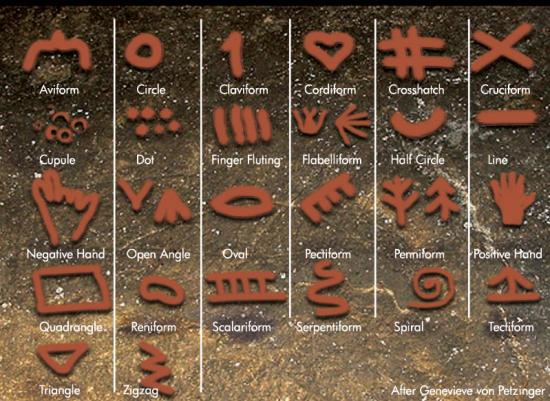An Introduction by the Bradshaw Foundation
Peter Robinson
Source - http://www.bradshawfoundation.com/geometric_signs/index.php
In 2010 Genevieve von Petzinger, based in Canada, initiated an unprecedented survey of ancient geometric signs.

Geometric signs have long been considered as important, and no cave art researcher has neglected them, at least since Leroi-Gourhan’s seminal work in the mid-1960's. What is new and exciting in Genevieve von Petzinger’s research is, thanks to the possibilities of the computer, she has completed a data base of the geometric signs from 146 painted caves, attempting to analyse their relationships to one another.
Genevieve, who has recently completed a MA degree in Anthropology at the University of Victoria in British Columbia, Canada, is researching the geometric signs present in rock art sites in Ice Age France. Her MA research focused on their large-scale temporal and spatial patterning.
Are geometric signs the first step towards symbolism? This might be the case in some contexts, but not all. For example, at Blombos in South Africa towards 75,000BP, or in Australia with the Panamaritee style, this may be the case. Dr Jean Clottes, however, feels that this may not be the case in the European painted caves: the signs in the caves are always (or nearly always) associated with animal figures and thus cannot be said to be the first steps towards symbolism; in any case, the animal figures are probably as symbolic as the signs.
Such is the case in the Niaux Cave, in the foothills of the French Pyrenees. The main entrance to Niaux leads into a large and even-floored cavern, wide and high-ceilinged. The cave walls are smooth and clear, but empty of cave art. For the first 400 metres there are no paintings or engravings. But at a particular point the open cavern becomes restricted, caused by an ancient collapse of enormous jagged boulders from the ceiling. Here there is a choice - one can continue into the cave by climbing with considerable difficulty up over the debris, or else squeeze through a narrow but level passage to the left. As one emerges from this, and on either side of the opening, the paintings begin as symbols. Simple linear lines in red seem to mark the beginning of the painted cave; the beginning of the experience. These enigmatic and understated decorations continue, with a hundred or so red and black geometric signs - dashes, bars, lines, and series of dots - some painted using tools, some using fingers. The red is hematite, the black is either manganese dioxide or charcoal, both ground and mixed with water or fat. They have been daubed strategically, sometimes opposite each other, sometimes on either side of a conspicuous fissure. Shortly after this, the animal figures appear, and the prehistoric dialogue continues to unfold.
Are the geometric signs a scripture that can eventually be deciphered? More research must be carried out before we answer this. At the moment, our understanding of geometric signs is that they do not have the characteristics of 'writing', which entails not only ideograms or pictograms (whose diverse meanings are entirely cultural). Moreover, they do not have a syntax. If there are not the systematic repetitions to be found in a well ordered syntax, we will never be able to guess at the precise meaning of the ideograms or even less at their organization within a panel.
What are Geometric Signs? | Worldwide Geometric Signs Chart
Research Methodology
Geometric Signs in France | Page | 1 | 2 |
Sign Types Present in Countries and Regions
Bibliography
Bibliography | for photos and drawings | A to L | N to Z |